A Report on Hazardous Waste Management, Regulations in Australia
VerifiedAdded on 2023/06/07
|12
|2477
|320
Report
AI Summary
This report, commissioned by the Australian Government Department of the Environment and Energy, analyzes hazardous waste management in Australia. It highlights key issues such as regulatory frameworks, the management of hazardous chemicals, training, data adequacy on waste management and recycling, and disposal standards, including adherence to the Basel Convention. The report identifies motivations and potential areas for improvement in national waste reporting, including data quality, integration of waste data, and the scope of recorded data. It also addresses the role of local governments in waste management and proposes improvements to national waste reporting based on findings from workshops and reviews. The report emphasizes the importance of raising awareness and incorporating better environmental practices to maximize existing resources and address the challenges in managing hazardous waste effectively. Desklib provides access to similar reports and solved assignments for students.

Paraphrase This Document
Need a fresh take? Get an instant paraphrase of this document with our AI Paraphraser
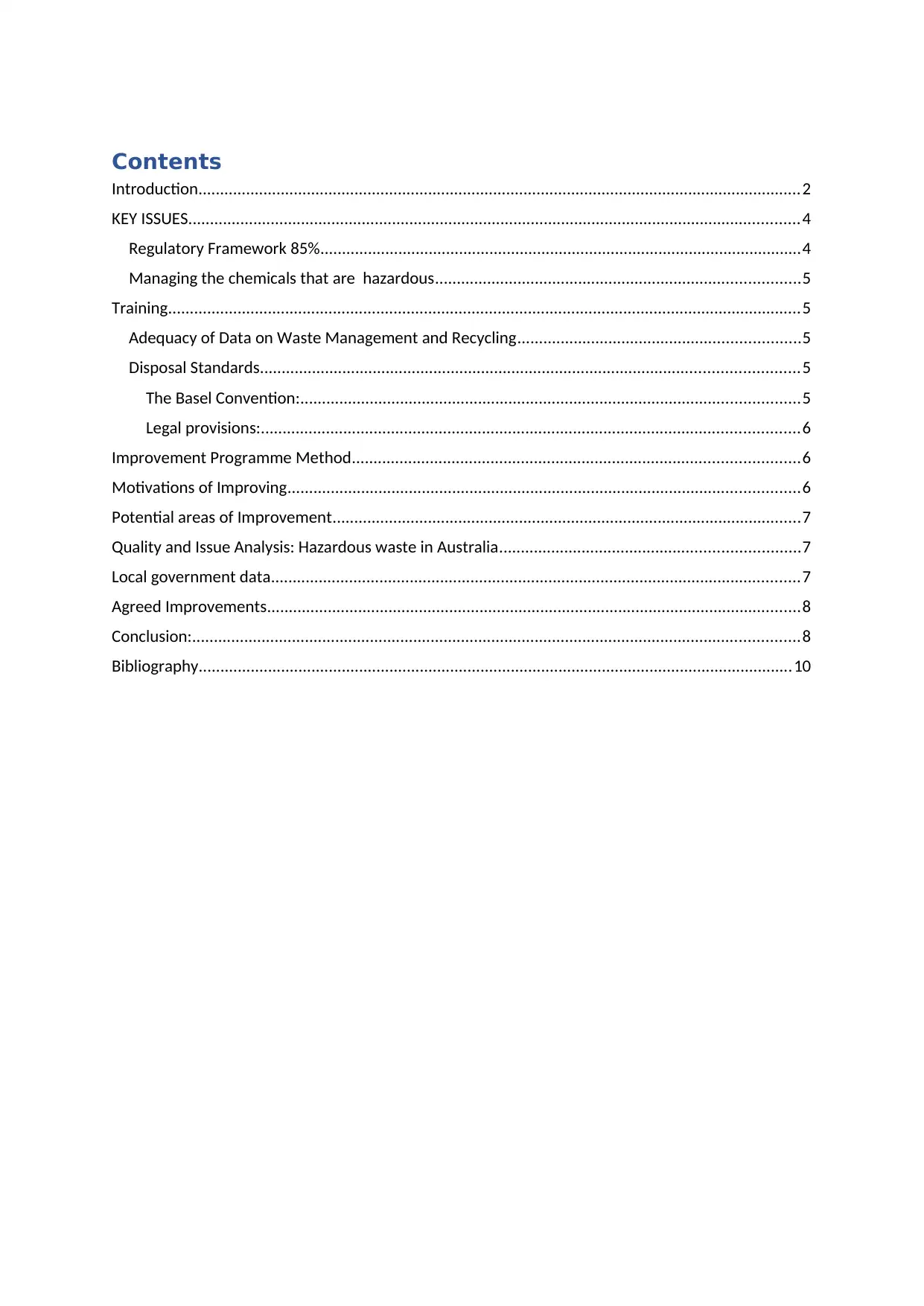
Contents
Introduction...........................................................................................................................................2
KEY ISSUES.............................................................................................................................................4
Regulatory Framework 85%...............................................................................................................4
Managing the chemicals that are hazardous....................................................................................5
Training..................................................................................................................................................5
Adequacy of Data on Waste Management and Recycling.................................................................5
Disposal Standards............................................................................................................................5
The Basel Convention:...................................................................................................................5
Legal provisions:............................................................................................................................6
Improvement Programme Method.......................................................................................................6
Motivations of Improving......................................................................................................................6
Potential areas of Improvement............................................................................................................7
Quality and Issue Analysis: Hazardous waste in Australia.....................................................................7
Local government data..........................................................................................................................7
Agreed Improvements...........................................................................................................................8
Conclusion:............................................................................................................................................8
Bibliography.........................................................................................................................................10
Introduction...........................................................................................................................................2
KEY ISSUES.............................................................................................................................................4
Regulatory Framework 85%...............................................................................................................4
Managing the chemicals that are hazardous....................................................................................5
Training..................................................................................................................................................5
Adequacy of Data on Waste Management and Recycling.................................................................5
Disposal Standards............................................................................................................................5
The Basel Convention:...................................................................................................................5
Legal provisions:............................................................................................................................6
Improvement Programme Method.......................................................................................................6
Motivations of Improving......................................................................................................................6
Potential areas of Improvement............................................................................................................7
Quality and Issue Analysis: Hazardous waste in Australia.....................................................................7
Local government data..........................................................................................................................7
Agreed Improvements...........................................................................................................................8
Conclusion:............................................................................................................................................8
Bibliography.........................................................................................................................................10
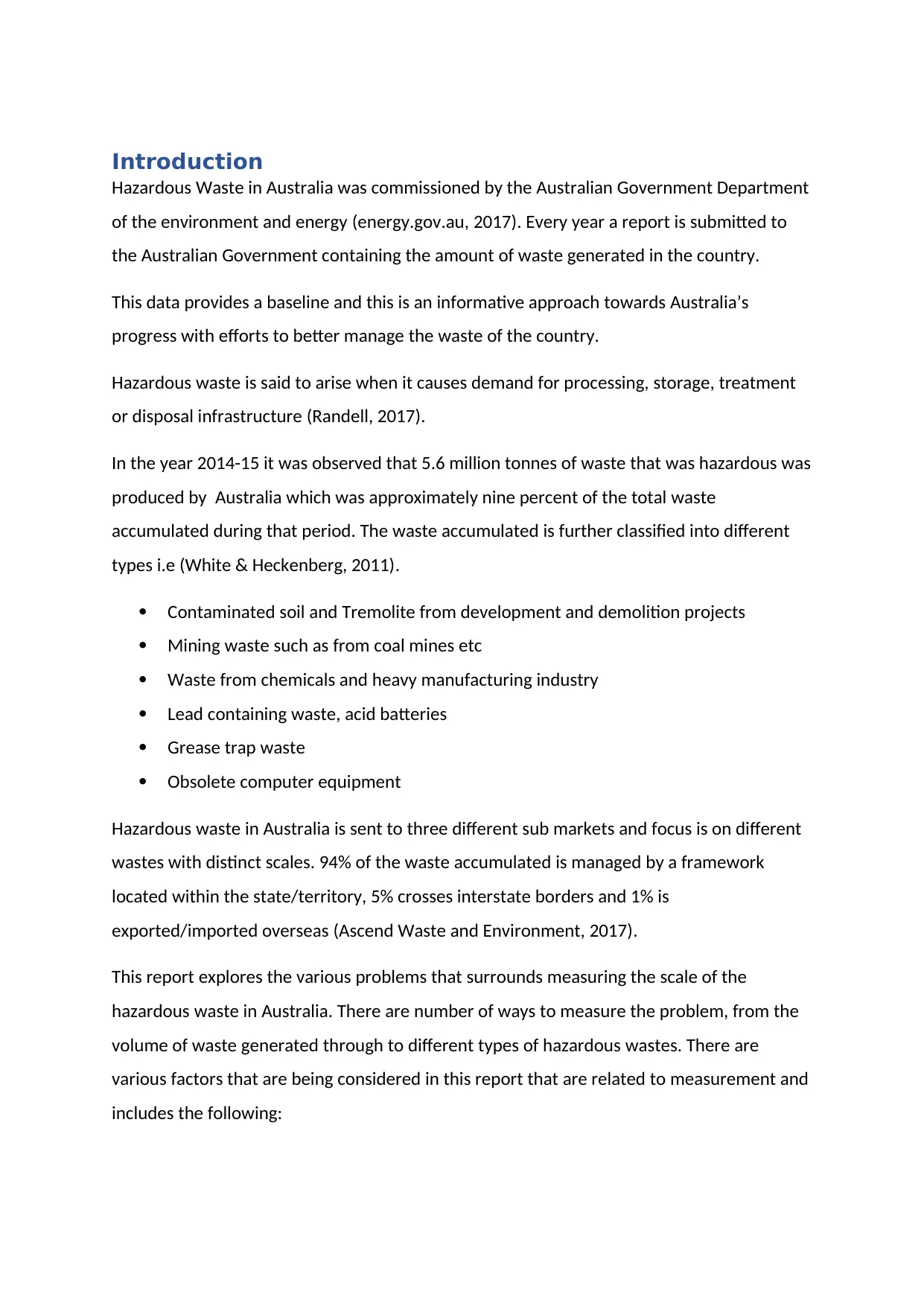
Introduction
Hazardous Waste in Australia was commissioned by the Australian Government Department
of the environment and energy (energy.gov.au, 2017). Every year a report is submitted to
the Australian Government containing the amount of waste generated in the country.
This data provides a baseline and this is an informative approach towards Australia’s
progress with efforts to better manage the waste of the country.
Hazardous waste is said to arise when it causes demand for processing, storage, treatment
or disposal infrastructure (Randell, 2017).
In the year 2014-15 it was observed that 5.6 million tonnes of waste that was hazardous was
produced by Australia which was approximately nine percent of the total waste
accumulated during that period. The waste accumulated is further classified into different
types i.e (White & Heckenberg, 2011).
Contaminated soil and Tremolite from development and demolition projects
Mining waste such as from coal mines etc
Waste from chemicals and heavy manufacturing industry
Lead containing waste, acid batteries
Grease trap waste
Obsolete computer equipment
Hazardous waste in Australia is sent to three different sub markets and focus is on different
wastes with distinct scales. 94% of the waste accumulated is managed by a framework
located within the state/territory, 5% crosses interstate borders and 1% is
exported/imported overseas (Ascend Waste and Environment, 2017).
This report explores the various problems that surrounds measuring the scale of the
hazardous waste in Australia. There are number of ways to measure the problem, from the
volume of waste generated through to different types of hazardous wastes. There are
various factors that are being considered in this report that are related to measurement and
includes the following:
Hazardous Waste in Australia was commissioned by the Australian Government Department
of the environment and energy (energy.gov.au, 2017). Every year a report is submitted to
the Australian Government containing the amount of waste generated in the country.
This data provides a baseline and this is an informative approach towards Australia’s
progress with efforts to better manage the waste of the country.
Hazardous waste is said to arise when it causes demand for processing, storage, treatment
or disposal infrastructure (Randell, 2017).
In the year 2014-15 it was observed that 5.6 million tonnes of waste that was hazardous was
produced by Australia which was approximately nine percent of the total waste
accumulated during that period. The waste accumulated is further classified into different
types i.e (White & Heckenberg, 2011).
Contaminated soil and Tremolite from development and demolition projects
Mining waste such as from coal mines etc
Waste from chemicals and heavy manufacturing industry
Lead containing waste, acid batteries
Grease trap waste
Obsolete computer equipment
Hazardous waste in Australia is sent to three different sub markets and focus is on different
wastes with distinct scales. 94% of the waste accumulated is managed by a framework
located within the state/territory, 5% crosses interstate borders and 1% is
exported/imported overseas (Ascend Waste and Environment, 2017).
This report explores the various problems that surrounds measuring the scale of the
hazardous waste in Australia. There are number of ways to measure the problem, from the
volume of waste generated through to different types of hazardous wastes. There are
various factors that are being considered in this report that are related to measurement and
includes the following:
⊘ This is a preview!⊘
Do you want full access?
Subscribe today to unlock all pages.

Trusted by 1+ million students worldwide
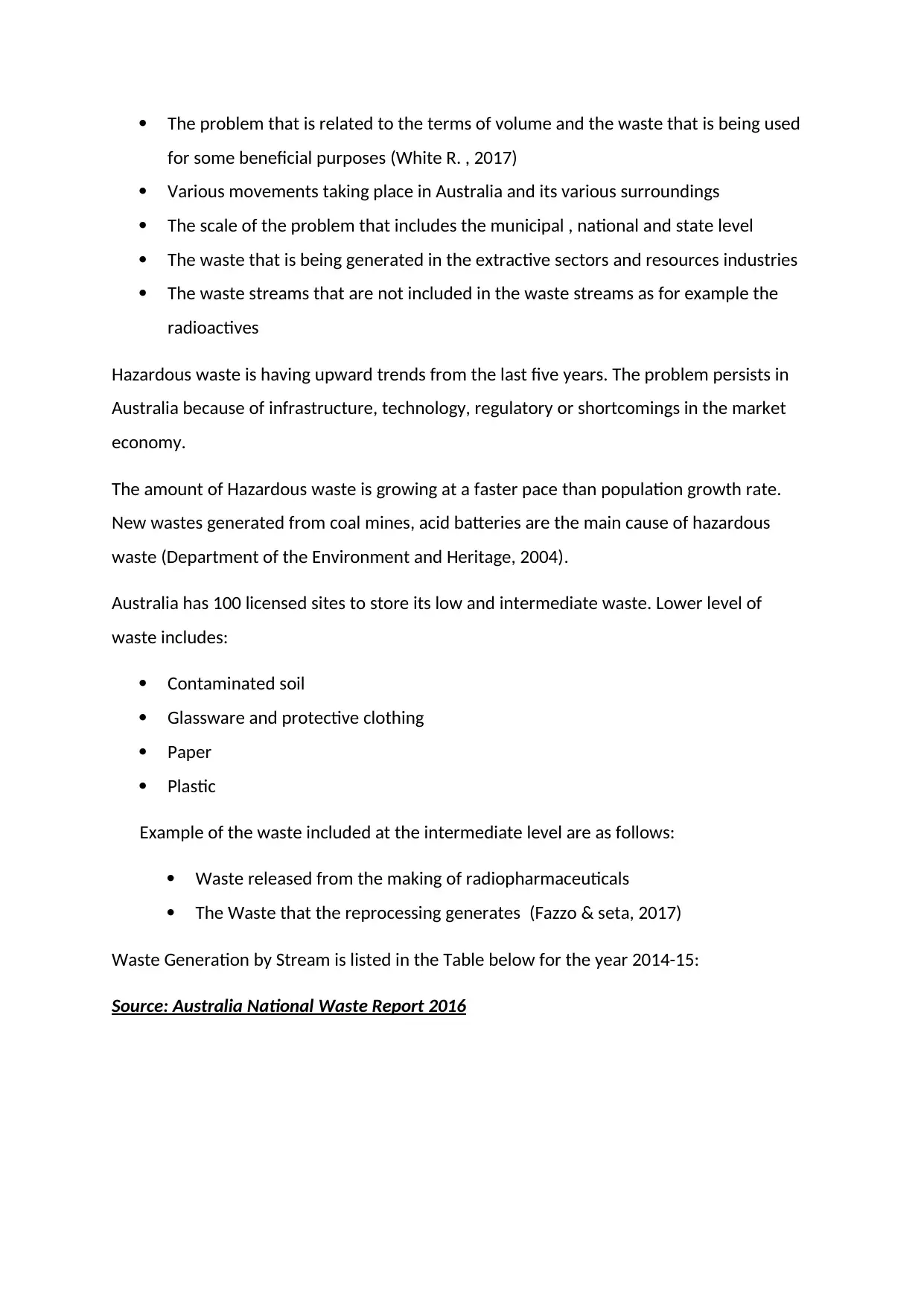
The problem that is related to the terms of volume and the waste that is being used
for some beneficial purposes (White R. , 2017)
Various movements taking place in Australia and its various surroundings
The scale of the problem that includes the municipal , national and state level
The waste that is being generated in the extractive sectors and resources industries
The waste streams that are not included in the waste streams as for example the
radioactives
Hazardous waste is having upward trends from the last five years. The problem persists in
Australia because of infrastructure, technology, regulatory or shortcomings in the market
economy.
The amount of Hazardous waste is growing at a faster pace than population growth rate.
New wastes generated from coal mines, acid batteries are the main cause of hazardous
waste (Department of the Environment and Heritage, 2004).
Australia has 100 licensed sites to store its low and intermediate waste. Lower level of
waste includes:
Contaminated soil
Glassware and protective clothing
Paper
Plastic
Example of the waste included at the intermediate level are as follows:
Waste released from the making of radiopharmaceuticals
The Waste that the reprocessing generates (Fazzo & seta, 2017)
Waste Generation by Stream is listed in the Table below for the year 2014-15:
Source: Australia National Waste Report 2016
for some beneficial purposes (White R. , 2017)
Various movements taking place in Australia and its various surroundings
The scale of the problem that includes the municipal , national and state level
The waste that is being generated in the extractive sectors and resources industries
The waste streams that are not included in the waste streams as for example the
radioactives
Hazardous waste is having upward trends from the last five years. The problem persists in
Australia because of infrastructure, technology, regulatory or shortcomings in the market
economy.
The amount of Hazardous waste is growing at a faster pace than population growth rate.
New wastes generated from coal mines, acid batteries are the main cause of hazardous
waste (Department of the Environment and Heritage, 2004).
Australia has 100 licensed sites to store its low and intermediate waste. Lower level of
waste includes:
Contaminated soil
Glassware and protective clothing
Paper
Plastic
Example of the waste included at the intermediate level are as follows:
Waste released from the making of radiopharmaceuticals
The Waste that the reprocessing generates (Fazzo & seta, 2017)
Waste Generation by Stream is listed in the Table below for the year 2014-15:
Source: Australia National Waste Report 2016
Paraphrase This Document
Need a fresh take? Get an instant paraphrase of this document with our AI Paraphraser
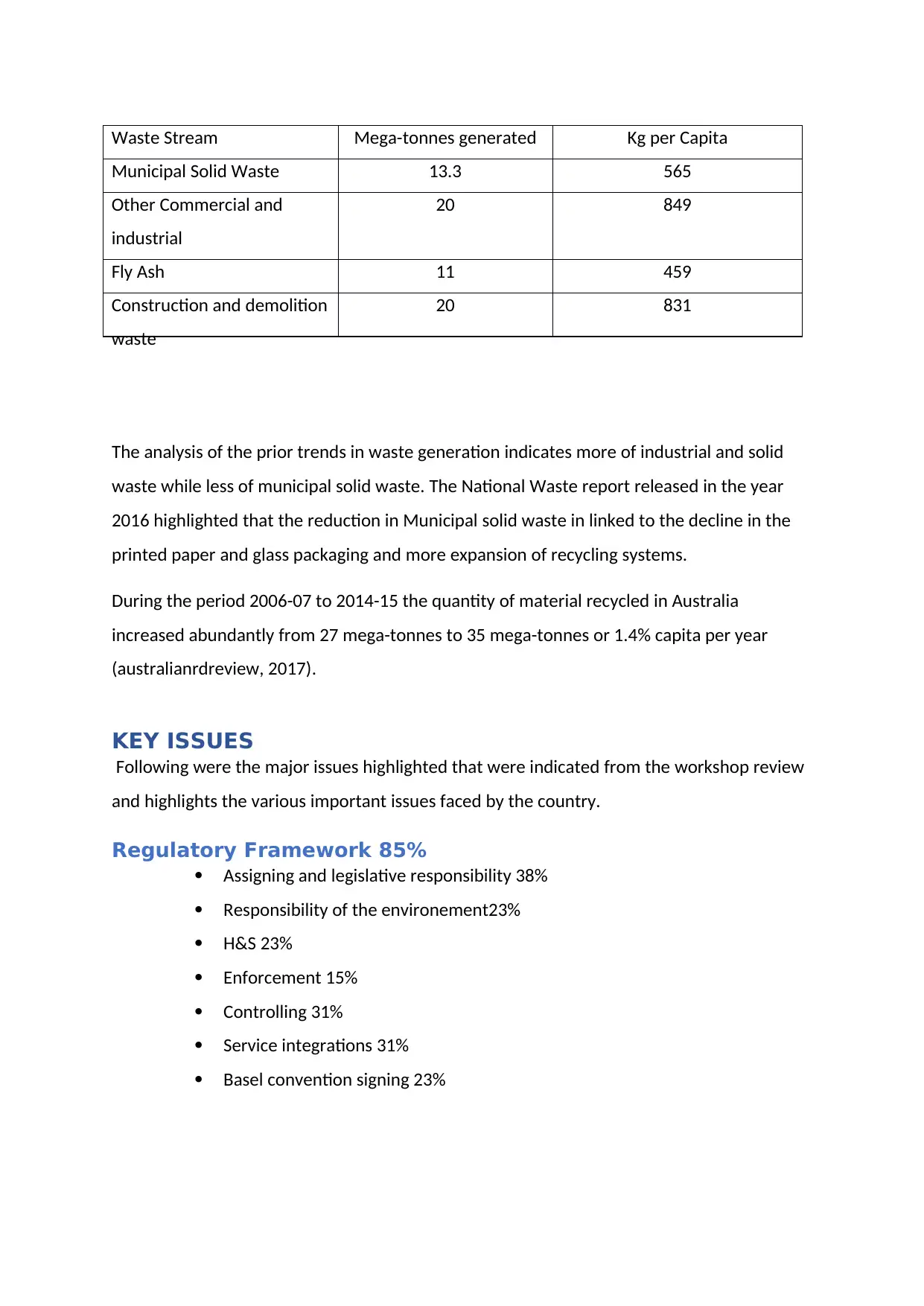
The analysis of the prior trends in waste generation indicates more of industrial and solid
waste while less of municipal solid waste. The National Waste report released in the year
2016 highlighted that the reduction in Municipal solid waste in linked to the decline in the
printed paper and glass packaging and more expansion of recycling systems.
During the period 2006-07 to 2014-15 the quantity of material recycled in Australia
increased abundantly from 27 mega-tonnes to 35 mega-tonnes or 1.4% capita per year
(australianrdreview, 2017).
KEY ISSUES
Following were the major issues highlighted that were indicated from the workshop review
and highlights the various important issues faced by the country.
Regulatory Framework 85%
Assigning and legislative responsibility 38%
Responsibility of the environement23%
H&S 23%
Enforcement 15%
Controlling 31%
Service integrations 31%
Basel convention signing 23%
Waste Stream Mega-tonnes generated Kg per Capita
Municipal Solid Waste 13.3 565
Other Commercial and
industrial
20 849
Fly Ash 11 459
Construction and demolition
waste
20 831
waste while less of municipal solid waste. The National Waste report released in the year
2016 highlighted that the reduction in Municipal solid waste in linked to the decline in the
printed paper and glass packaging and more expansion of recycling systems.
During the period 2006-07 to 2014-15 the quantity of material recycled in Australia
increased abundantly from 27 mega-tonnes to 35 mega-tonnes or 1.4% capita per year
(australianrdreview, 2017).
KEY ISSUES
Following were the major issues highlighted that were indicated from the workshop review
and highlights the various important issues faced by the country.
Regulatory Framework 85%
Assigning and legislative responsibility 38%
Responsibility of the environement23%
H&S 23%
Enforcement 15%
Controlling 31%
Service integrations 31%
Basel convention signing 23%
Waste Stream Mega-tonnes generated Kg per Capita
Municipal Solid Waste 13.3 565
Other Commercial and
industrial
20 849
Fly Ash 11 459
Construction and demolition
waste
20 831
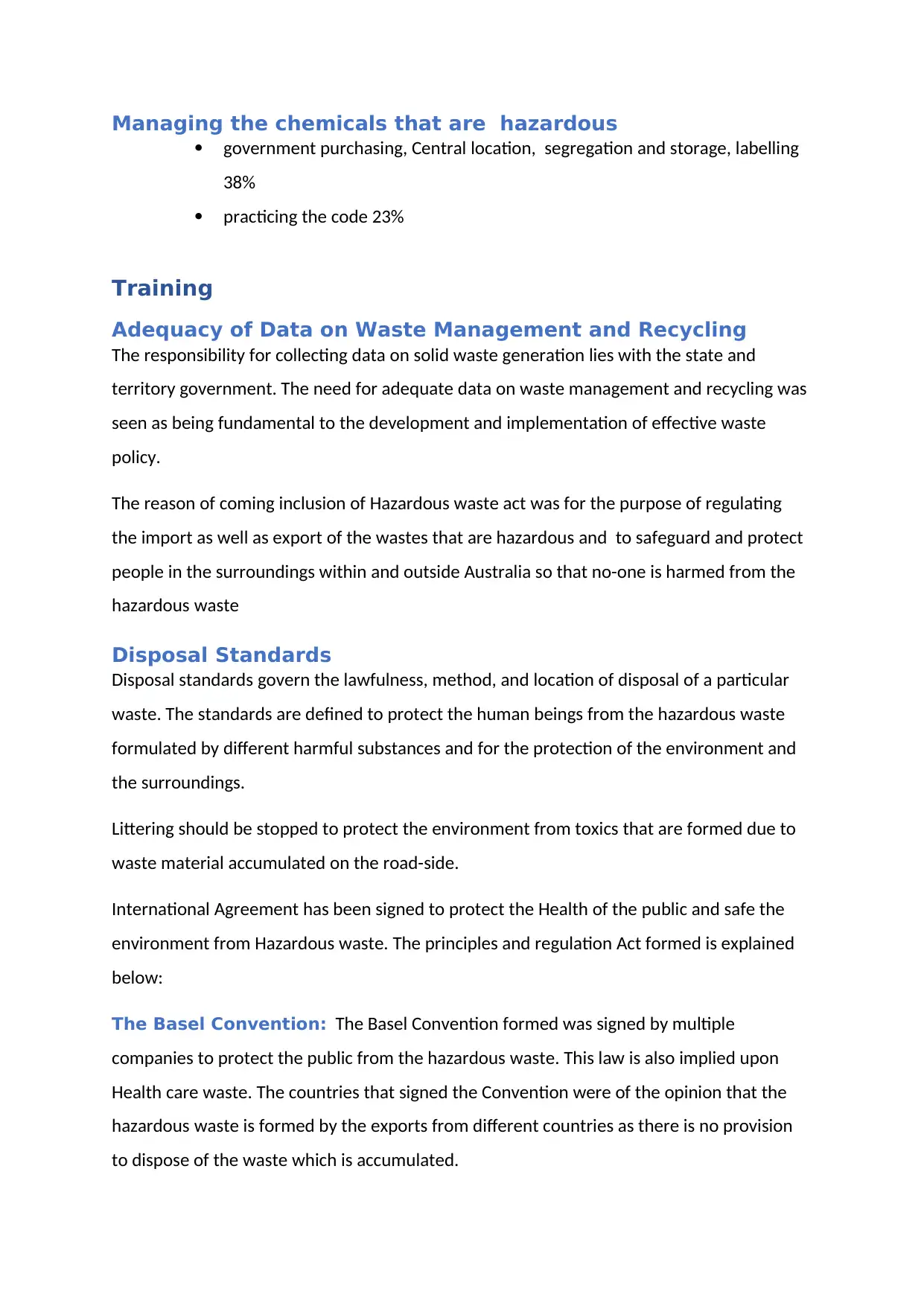
Managing the chemicals that are hazardous
government purchasing, Central location, segregation and storage, labelling
38%
practicing the code 23%
Training
Adequacy of Data on Waste Management and Recycling
The responsibility for collecting data on solid waste generation lies with the state and
territory government. The need for adequate data on waste management and recycling was
seen as being fundamental to the development and implementation of effective waste
policy.
The reason of coming inclusion of Hazardous waste act was for the purpose of regulating
the import as well as export of the wastes that are hazardous and to safeguard and protect
people in the surroundings within and outside Australia so that no-one is harmed from the
hazardous waste
Disposal Standards
Disposal standards govern the lawfulness, method, and location of disposal of a particular
waste. The standards are defined to protect the human beings from the hazardous waste
formulated by different harmful substances and for the protection of the environment and
the surroundings.
Littering should be stopped to protect the environment from toxics that are formed due to
waste material accumulated on the road-side.
International Agreement has been signed to protect the Health of the public and safe the
environment from Hazardous waste. The principles and regulation Act formed is explained
below:
The Basel Convention: The Basel Convention formed was signed by multiple
companies to protect the public from the hazardous waste. This law is also implied upon
Health care waste. The countries that signed the Convention were of the opinion that the
hazardous waste is formed by the exports from different countries as there is no provision
to dispose of the waste which is accumulated.
government purchasing, Central location, segregation and storage, labelling
38%
practicing the code 23%
Training
Adequacy of Data on Waste Management and Recycling
The responsibility for collecting data on solid waste generation lies with the state and
territory government. The need for adequate data on waste management and recycling was
seen as being fundamental to the development and implementation of effective waste
policy.
The reason of coming inclusion of Hazardous waste act was for the purpose of regulating
the import as well as export of the wastes that are hazardous and to safeguard and protect
people in the surroundings within and outside Australia so that no-one is harmed from the
hazardous waste
Disposal Standards
Disposal standards govern the lawfulness, method, and location of disposal of a particular
waste. The standards are defined to protect the human beings from the hazardous waste
formulated by different harmful substances and for the protection of the environment and
the surroundings.
Littering should be stopped to protect the environment from toxics that are formed due to
waste material accumulated on the road-side.
International Agreement has been signed to protect the Health of the public and safe the
environment from Hazardous waste. The principles and regulation Act formed is explained
below:
The Basel Convention: The Basel Convention formed was signed by multiple
companies to protect the public from the hazardous waste. This law is also implied upon
Health care waste. The countries that signed the Convention were of the opinion that the
hazardous waste is formed by the exports from different countries as there is no provision
to dispose of the waste which is accumulated.
⊘ This is a preview!⊘
Do you want full access?
Subscribe today to unlock all pages.

Trusted by 1+ million students worldwide
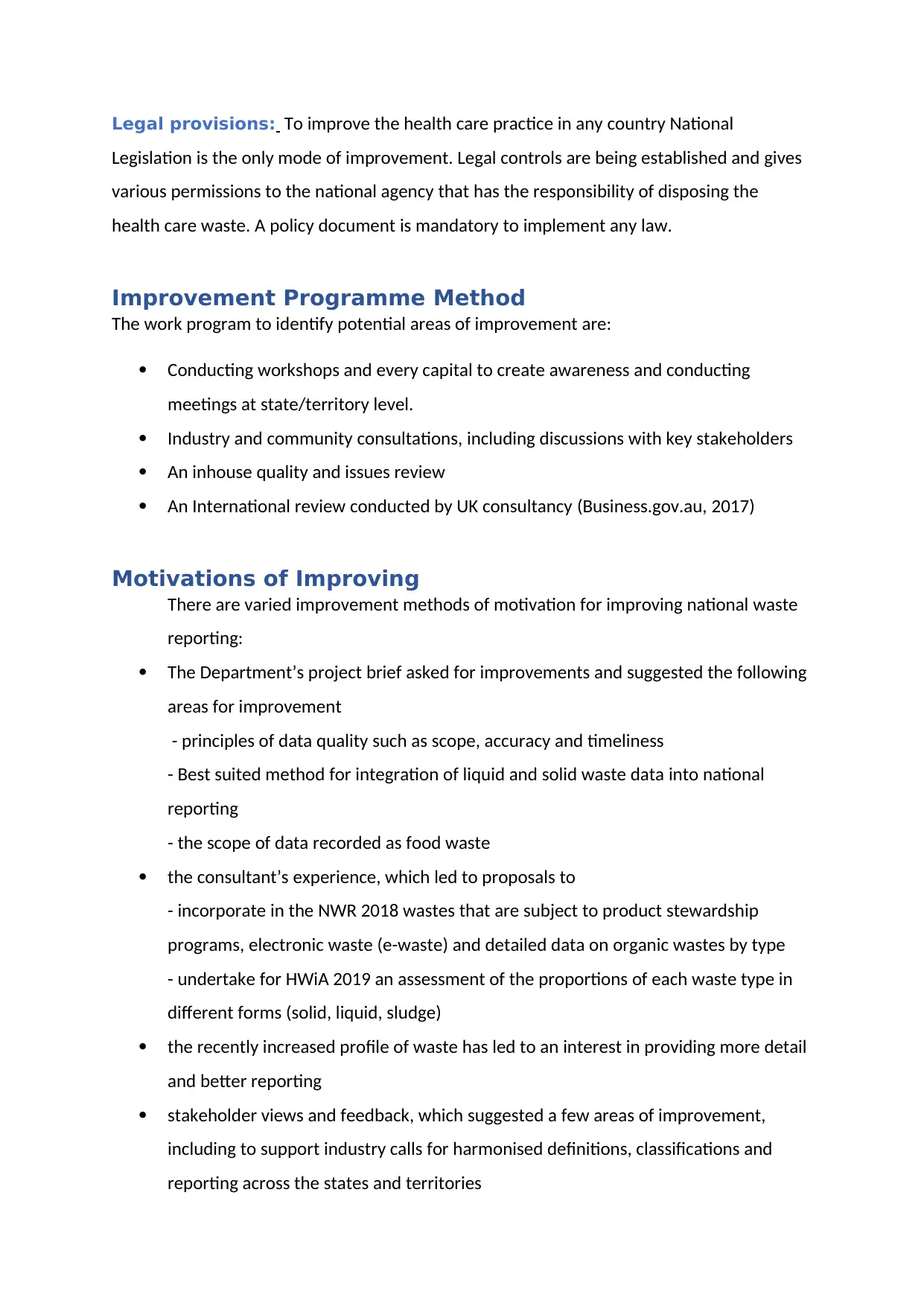
Legal provisions: To improve the health care practice in any country National
Legislation is the only mode of improvement. Legal controls are being established and gives
various permissions to the national agency that has the responsibility of disposing the
health care waste. A policy document is mandatory to implement any law.
Improvement Programme Method
The work program to identify potential areas of improvement are:
Conducting workshops and every capital to create awareness and conducting
meetings at state/territory level.
Industry and community consultations, including discussions with key stakeholders
An inhouse quality and issues review
An International review conducted by UK consultancy (Business.gov.au, 2017)
Motivations of Improving
There are varied improvement methods of motivation for improving national waste
reporting:
The Department’s project brief asked for improvements and suggested the following
areas for improvement
- principles of data quality such as scope, accuracy and timeliness
- Best suited method for integration of liquid and solid waste data into national
reporting
- the scope of data recorded as food waste
the consultant’s experience, which led to proposals to
- incorporate in the NWR 2018 wastes that are subject to product stewardship
programs, electronic waste (e-waste) and detailed data on organic wastes by type
- undertake for HWiA 2019 an assessment of the proportions of each waste type in
different forms (solid, liquid, sludge)
the recently increased profile of waste has led to an interest in providing more detail
and better reporting
stakeholder views and feedback, which suggested a few areas of improvement,
including to support industry calls for harmonised definitions, classifications and
reporting across the states and territories
Legislation is the only mode of improvement. Legal controls are being established and gives
various permissions to the national agency that has the responsibility of disposing the
health care waste. A policy document is mandatory to implement any law.
Improvement Programme Method
The work program to identify potential areas of improvement are:
Conducting workshops and every capital to create awareness and conducting
meetings at state/territory level.
Industry and community consultations, including discussions with key stakeholders
An inhouse quality and issues review
An International review conducted by UK consultancy (Business.gov.au, 2017)
Motivations of Improving
There are varied improvement methods of motivation for improving national waste
reporting:
The Department’s project brief asked for improvements and suggested the following
areas for improvement
- principles of data quality such as scope, accuracy and timeliness
- Best suited method for integration of liquid and solid waste data into national
reporting
- the scope of data recorded as food waste
the consultant’s experience, which led to proposals to
- incorporate in the NWR 2018 wastes that are subject to product stewardship
programs, electronic waste (e-waste) and detailed data on organic wastes by type
- undertake for HWiA 2019 an assessment of the proportions of each waste type in
different forms (solid, liquid, sludge)
the recently increased profile of waste has led to an interest in providing more detail
and better reporting
stakeholder views and feedback, which suggested a few areas of improvement,
including to support industry calls for harmonised definitions, classifications and
reporting across the states and territories
Paraphrase This Document
Need a fresh take? Get an instant paraphrase of this document with our AI Paraphraser
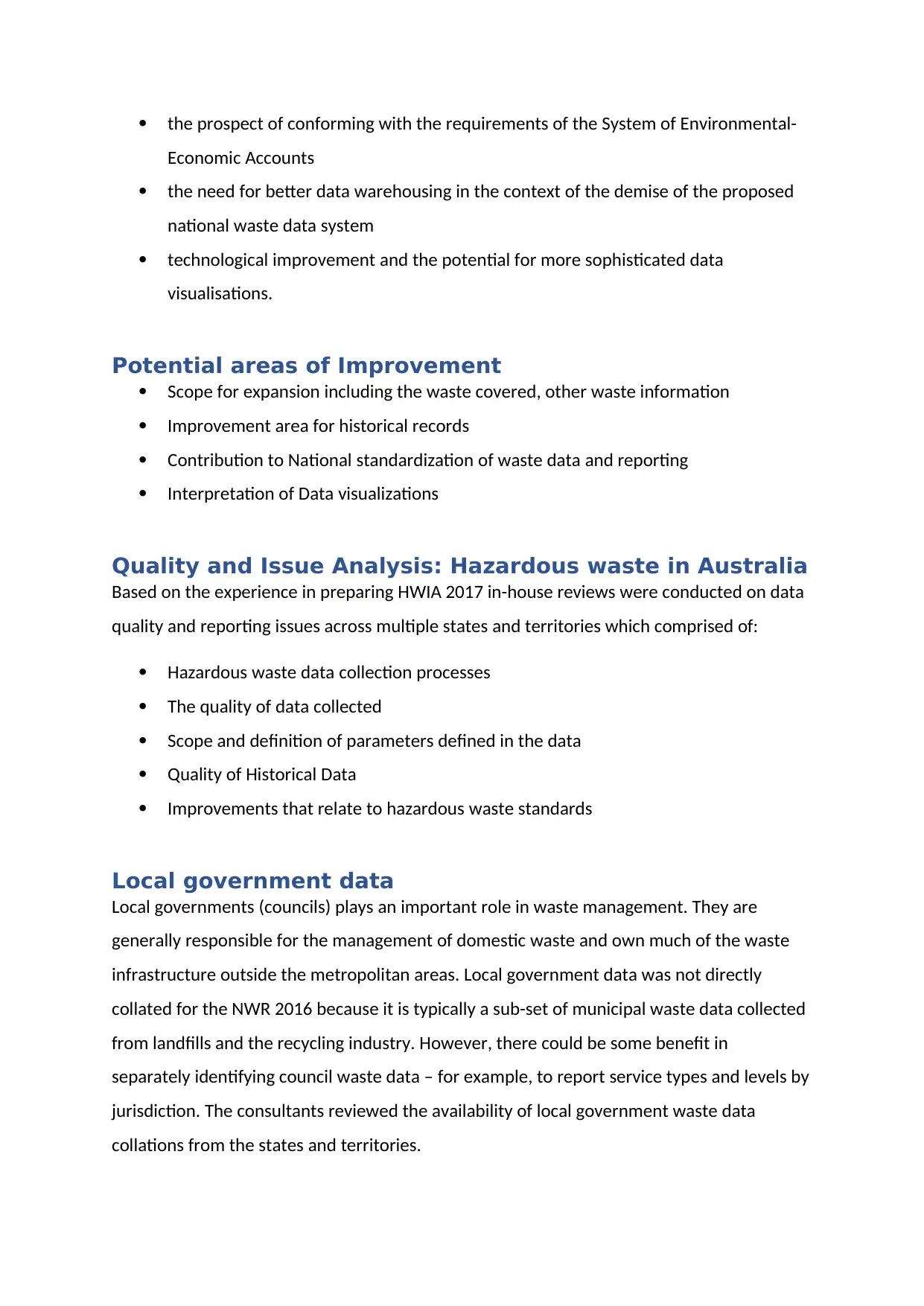
the prospect of conforming with the requirements of the System of Environmental-
Economic Accounts
the need for better data warehousing in the context of the demise of the proposed
national waste data system
technological improvement and the potential for more sophisticated data
visualisations.
Potential areas of Improvement
Scope for expansion including the waste covered, other waste information
Improvement area for historical records
Contribution to National standardization of waste data and reporting
Interpretation of Data visualizations
Quality and Issue Analysis: Hazardous waste in Australia
Based on the experience in preparing HWIA 2017 in-house reviews were conducted on data
quality and reporting issues across multiple states and territories which comprised of:
Hazardous waste data collection processes
The quality of data collected
Scope and definition of parameters defined in the data
Quality of Historical Data
Improvements that relate to hazardous waste standards
Local government data
Local governments (councils) plays an important role in waste management. They are
generally responsible for the management of domestic waste and own much of the waste
infrastructure outside the metropolitan areas. Local government data was not directly
collated for the NWR 2016 because it is typically a sub-set of municipal waste data collected
from landfills and the recycling industry. However, there could be some benefit in
separately identifying council waste data – for example, to report service types and levels by
jurisdiction. The consultants reviewed the availability of local government waste data
collations from the states and territories.
Economic Accounts
the need for better data warehousing in the context of the demise of the proposed
national waste data system
technological improvement and the potential for more sophisticated data
visualisations.
Potential areas of Improvement
Scope for expansion including the waste covered, other waste information
Improvement area for historical records
Contribution to National standardization of waste data and reporting
Interpretation of Data visualizations
Quality and Issue Analysis: Hazardous waste in Australia
Based on the experience in preparing HWIA 2017 in-house reviews were conducted on data
quality and reporting issues across multiple states and territories which comprised of:
Hazardous waste data collection processes
The quality of data collected
Scope and definition of parameters defined in the data
Quality of Historical Data
Improvements that relate to hazardous waste standards
Local government data
Local governments (councils) plays an important role in waste management. They are
generally responsible for the management of domestic waste and own much of the waste
infrastructure outside the metropolitan areas. Local government data was not directly
collated for the NWR 2016 because it is typically a sub-set of municipal waste data collected
from landfills and the recycling industry. However, there could be some benefit in
separately identifying council waste data – for example, to report service types and levels by
jurisdiction. The consultants reviewed the availability of local government waste data
collations from the states and territories.
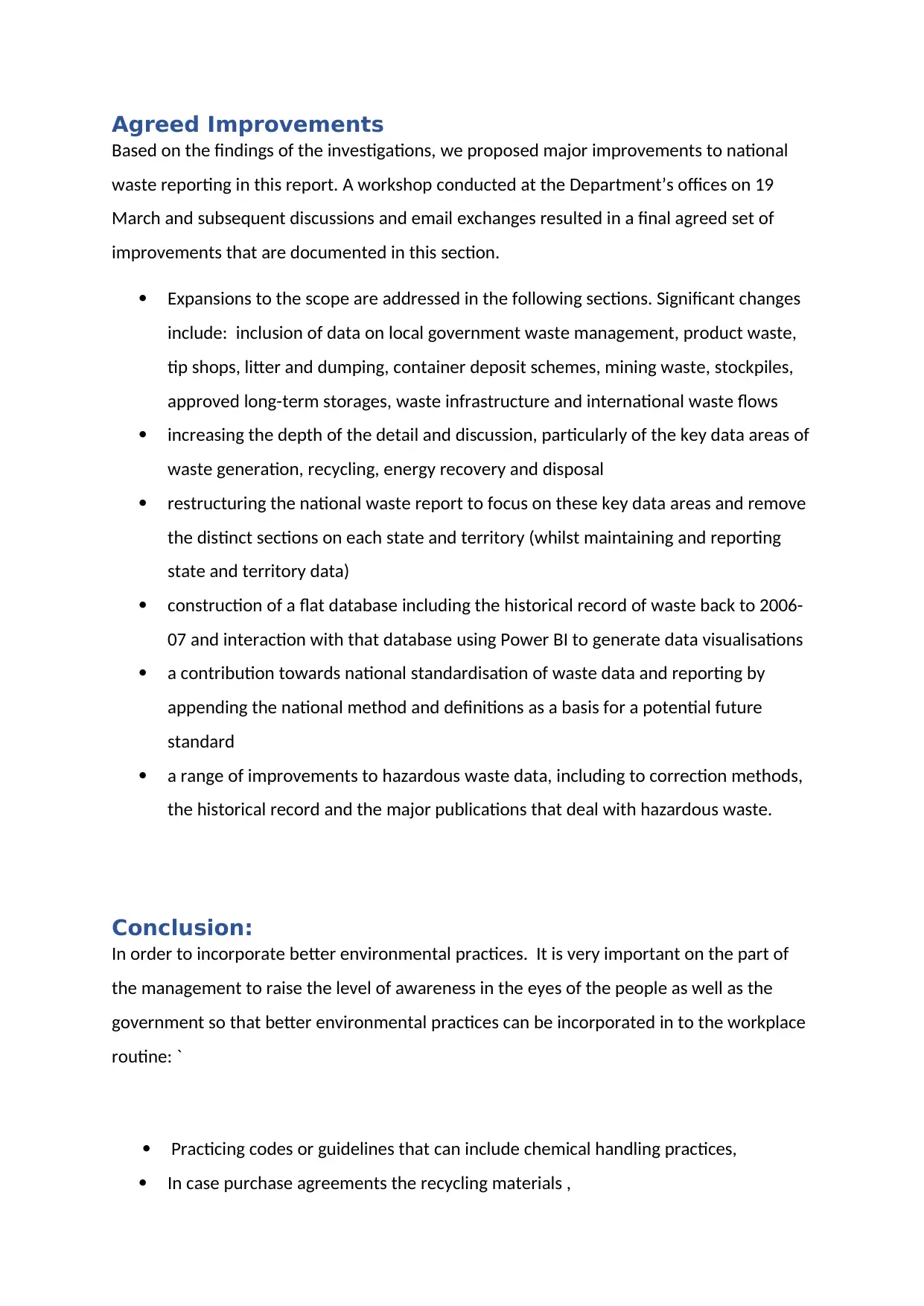
Agreed Improvements
Based on the findings of the investigations, we proposed major improvements to national
waste reporting in this report. A workshop conducted at the Department’s offices on 19
March and subsequent discussions and email exchanges resulted in a final agreed set of
improvements that are documented in this section.
Expansions to the scope are addressed in the following sections. Significant changes
include: inclusion of data on local government waste management, product waste,
tip shops, litter and dumping, container deposit schemes, mining waste, stockpiles,
approved long-term storages, waste infrastructure and international waste flows
increasing the depth of the detail and discussion, particularly of the key data areas of
waste generation, recycling, energy recovery and disposal
restructuring the national waste report to focus on these key data areas and remove
the distinct sections on each state and territory (whilst maintaining and reporting
state and territory data)
construction of a flat database including the historical record of waste back to 2006-
07 and interaction with that database using Power BI to generate data visualisations
a contribution towards national standardisation of waste data and reporting by
appending the national method and definitions as a basis for a potential future
standard
a range of improvements to hazardous waste data, including to correction methods,
the historical record and the major publications that deal with hazardous waste.
Conclusion:
In order to incorporate better environmental practices. It is very important on the part of
the management to raise the level of awareness in the eyes of the people as well as the
government so that better environmental practices can be incorporated in to the workplace
routine: `
Practicing codes or guidelines that can include chemical handling practices,
In case purchase agreements the recycling materials ,
Based on the findings of the investigations, we proposed major improvements to national
waste reporting in this report. A workshop conducted at the Department’s offices on 19
March and subsequent discussions and email exchanges resulted in a final agreed set of
improvements that are documented in this section.
Expansions to the scope are addressed in the following sections. Significant changes
include: inclusion of data on local government waste management, product waste,
tip shops, litter and dumping, container deposit schemes, mining waste, stockpiles,
approved long-term storages, waste infrastructure and international waste flows
increasing the depth of the detail and discussion, particularly of the key data areas of
waste generation, recycling, energy recovery and disposal
restructuring the national waste report to focus on these key data areas and remove
the distinct sections on each state and territory (whilst maintaining and reporting
state and territory data)
construction of a flat database including the historical record of waste back to 2006-
07 and interaction with that database using Power BI to generate data visualisations
a contribution towards national standardisation of waste data and reporting by
appending the national method and definitions as a basis for a potential future
standard
a range of improvements to hazardous waste data, including to correction methods,
the historical record and the major publications that deal with hazardous waste.
Conclusion:
In order to incorporate better environmental practices. It is very important on the part of
the management to raise the level of awareness in the eyes of the people as well as the
government so that better environmental practices can be incorporated in to the workplace
routine: `
Practicing codes or guidelines that can include chemical handling practices,
In case purchase agreements the recycling materials ,
⊘ This is a preview!⊘
Do you want full access?
Subscribe today to unlock all pages.

Trusted by 1+ million students worldwide
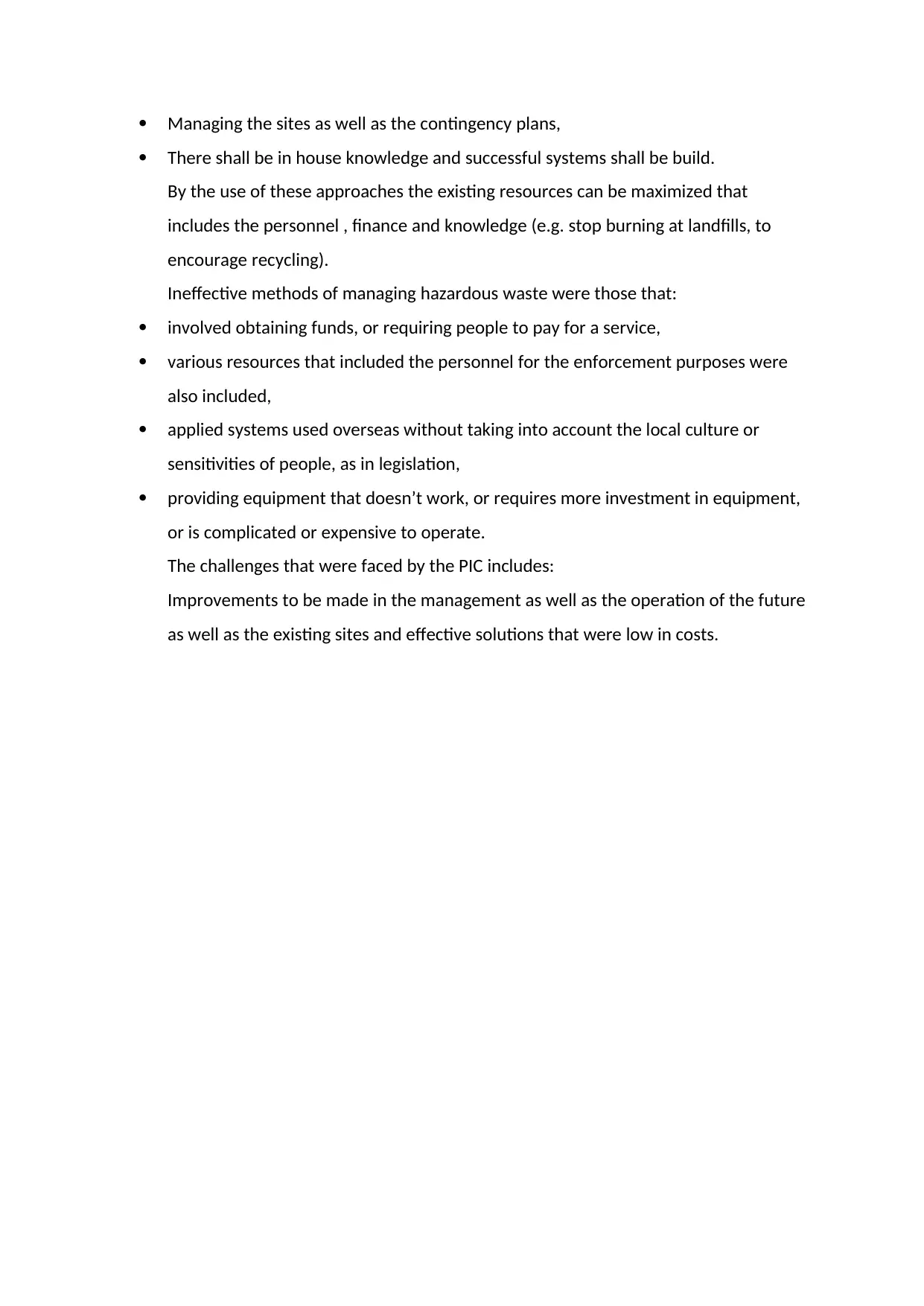
Managing the sites as well as the contingency plans,
There shall be in house knowledge and successful systems shall be build.
By the use of these approaches the existing resources can be maximized that
includes the personnel , finance and knowledge (e.g. stop burning at landfills, to
encourage recycling).
Ineffective methods of managing hazardous waste were those that:
involved obtaining funds, or requiring people to pay for a service,
various resources that included the personnel for the enforcement purposes were
also included,
applied systems used overseas without taking into account the local culture or
sensitivities of people, as in legislation,
providing equipment that doesn’t work, or requires more investment in equipment,
or is complicated or expensive to operate.
The challenges that were faced by the PIC includes:
Improvements to be made in the management as well as the operation of the future
as well as the existing sites and effective solutions that were low in costs.
There shall be in house knowledge and successful systems shall be build.
By the use of these approaches the existing resources can be maximized that
includes the personnel , finance and knowledge (e.g. stop burning at landfills, to
encourage recycling).
Ineffective methods of managing hazardous waste were those that:
involved obtaining funds, or requiring people to pay for a service,
various resources that included the personnel for the enforcement purposes were
also included,
applied systems used overseas without taking into account the local culture or
sensitivities of people, as in legislation,
providing equipment that doesn’t work, or requires more investment in equipment,
or is complicated or expensive to operate.
The challenges that were faced by the PIC includes:
Improvements to be made in the management as well as the operation of the future
as well as the existing sites and effective solutions that were low in costs.
Paraphrase This Document
Need a fresh take? Get an instant paraphrase of this document with our AI Paraphraser
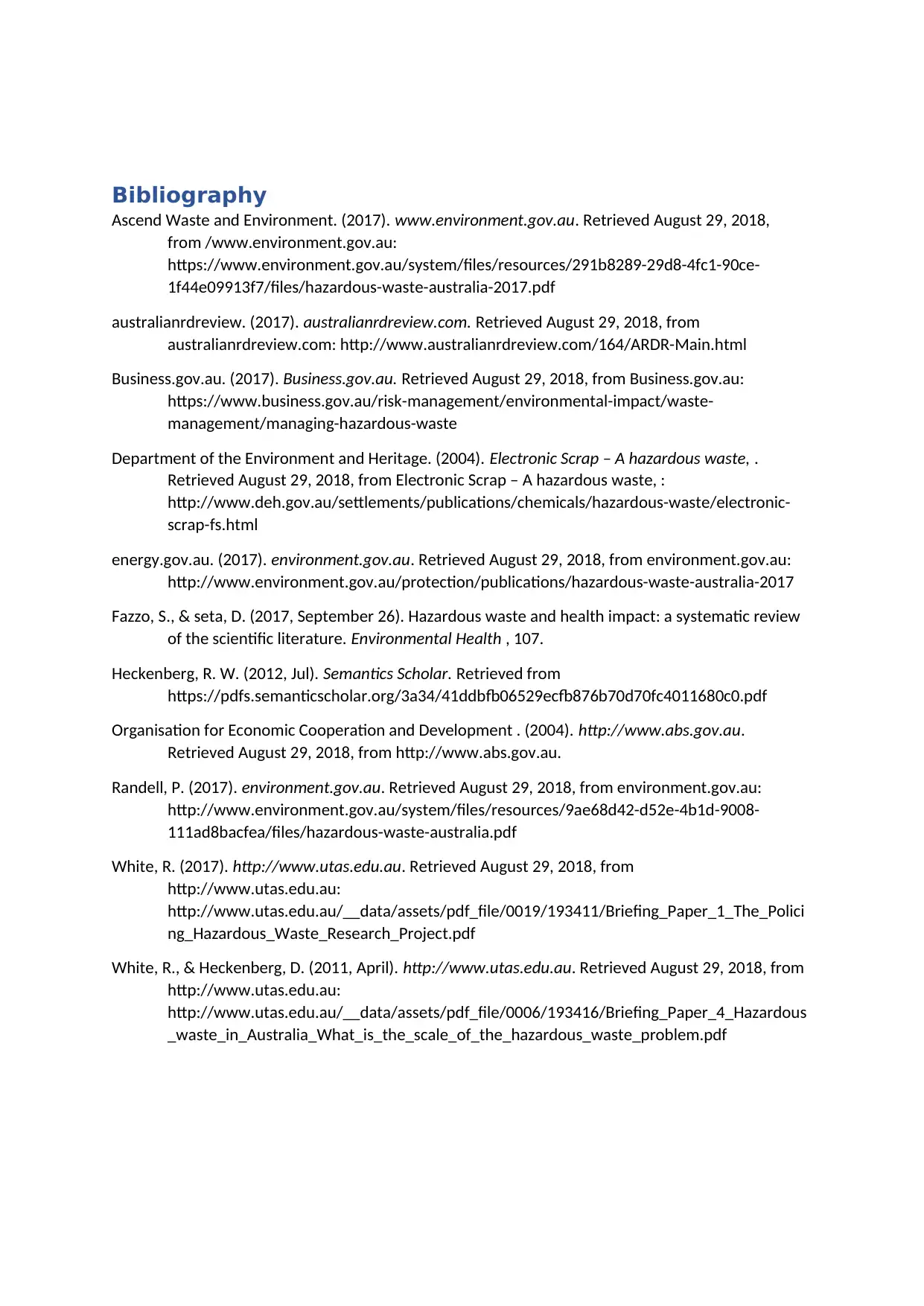
Bibliography
Ascend Waste and Environment. (2017). www.environment.gov.au. Retrieved August 29, 2018,
from /www.environment.gov.au:
https://www.environment.gov.au/system/files/resources/291b8289-29d8-4fc1-90ce-
1f44e09913f7/files/hazardous-waste-australia-2017.pdf
australianrdreview. (2017). australianrdreview.com. Retrieved August 29, 2018, from
australianrdreview.com: http://www.australianrdreview.com/164/ARDR-Main.html
Business.gov.au. (2017). Business.gov.au. Retrieved August 29, 2018, from Business.gov.au:
https://www.business.gov.au/risk-management/environmental-impact/waste-
management/managing-hazardous-waste
Department of the Environment and Heritage. (2004). Electronic Scrap – A hazardous waste, .
Retrieved August 29, 2018, from Electronic Scrap – A hazardous waste, :
http://www.deh.gov.au/settlements/publications/chemicals/hazardous-waste/electronic-
scrap-fs.html
energy.gov.au. (2017). environment.gov.au. Retrieved August 29, 2018, from environment.gov.au:
http://www.environment.gov.au/protection/publications/hazardous-waste-australia-2017
Fazzo, S., & seta, D. (2017, September 26). Hazardous waste and health impact: a systematic review
of the scientific literature. Environmental Health , 107.
Heckenberg, R. W. (2012, Jul). Semantics Scholar. Retrieved from
https://pdfs.semanticscholar.org/3a34/41ddbfb06529ecfb876b70d70fc4011680c0.pdf
Organisation for Economic Cooperation and Development . (2004). http://www.abs.gov.au.
Retrieved August 29, 2018, from http://www.abs.gov.au.
Randell, P. (2017). environment.gov.au. Retrieved August 29, 2018, from environment.gov.au:
http://www.environment.gov.au/system/files/resources/9ae68d42-d52e-4b1d-9008-
111ad8bacfea/files/hazardous-waste-australia.pdf
White, R. (2017). http://www.utas.edu.au. Retrieved August 29, 2018, from
http://www.utas.edu.au:
http://www.utas.edu.au/__data/assets/pdf_file/0019/193411/Briefing_Paper_1_The_Polici
ng_Hazardous_Waste_Research_Project.pdf
White, R., & Heckenberg, D. (2011, April). http://www.utas.edu.au. Retrieved August 29, 2018, from
http://www.utas.edu.au:
http://www.utas.edu.au/__data/assets/pdf_file/0006/193416/Briefing_Paper_4_Hazardous
_waste_in_Australia_What_is_the_scale_of_the_hazardous_waste_problem.pdf
Ascend Waste and Environment. (2017). www.environment.gov.au. Retrieved August 29, 2018,
from /www.environment.gov.au:
https://www.environment.gov.au/system/files/resources/291b8289-29d8-4fc1-90ce-
1f44e09913f7/files/hazardous-waste-australia-2017.pdf
australianrdreview. (2017). australianrdreview.com. Retrieved August 29, 2018, from
australianrdreview.com: http://www.australianrdreview.com/164/ARDR-Main.html
Business.gov.au. (2017). Business.gov.au. Retrieved August 29, 2018, from Business.gov.au:
https://www.business.gov.au/risk-management/environmental-impact/waste-
management/managing-hazardous-waste
Department of the Environment and Heritage. (2004). Electronic Scrap – A hazardous waste, .
Retrieved August 29, 2018, from Electronic Scrap – A hazardous waste, :
http://www.deh.gov.au/settlements/publications/chemicals/hazardous-waste/electronic-
scrap-fs.html
energy.gov.au. (2017). environment.gov.au. Retrieved August 29, 2018, from environment.gov.au:
http://www.environment.gov.au/protection/publications/hazardous-waste-australia-2017
Fazzo, S., & seta, D. (2017, September 26). Hazardous waste and health impact: a systematic review
of the scientific literature. Environmental Health , 107.
Heckenberg, R. W. (2012, Jul). Semantics Scholar. Retrieved from
https://pdfs.semanticscholar.org/3a34/41ddbfb06529ecfb876b70d70fc4011680c0.pdf
Organisation for Economic Cooperation and Development . (2004). http://www.abs.gov.au.
Retrieved August 29, 2018, from http://www.abs.gov.au.
Randell, P. (2017). environment.gov.au. Retrieved August 29, 2018, from environment.gov.au:
http://www.environment.gov.au/system/files/resources/9ae68d42-d52e-4b1d-9008-
111ad8bacfea/files/hazardous-waste-australia.pdf
White, R. (2017). http://www.utas.edu.au. Retrieved August 29, 2018, from
http://www.utas.edu.au:
http://www.utas.edu.au/__data/assets/pdf_file/0019/193411/Briefing_Paper_1_The_Polici
ng_Hazardous_Waste_Research_Project.pdf
White, R., & Heckenberg, D. (2011, April). http://www.utas.edu.au. Retrieved August 29, 2018, from
http://www.utas.edu.au:
http://www.utas.edu.au/__data/assets/pdf_file/0006/193416/Briefing_Paper_4_Hazardous
_waste_in_Australia_What_is_the_scale_of_the_hazardous_waste_problem.pdf

⊘ This is a preview!⊘
Do you want full access?
Subscribe today to unlock all pages.

Trusted by 1+ million students worldwide
1 out of 12
Your All-in-One AI-Powered Toolkit for Academic Success.
+13062052269
info@desklib.com
Available 24*7 on WhatsApp / Email
![[object Object]](/_next/static/media/star-bottom.7253800d.svg)
Unlock your academic potential
Copyright © 2020–2025 A2Z Services. All Rights Reserved. Developed and managed by ZUCOL.

